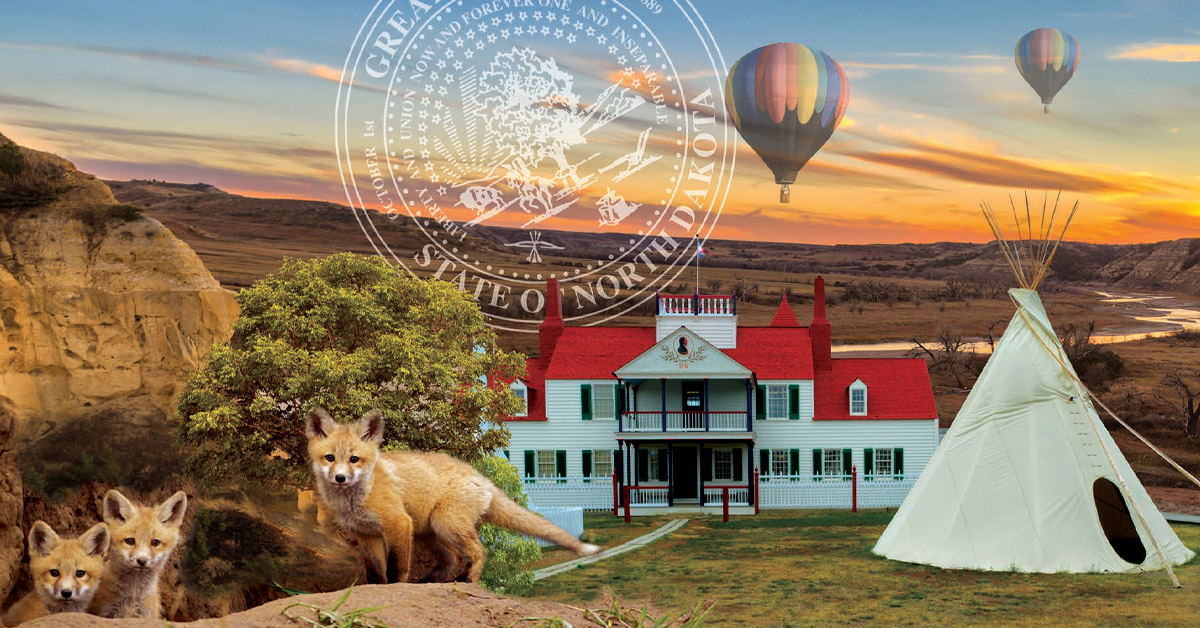North Dakota, which became the 39th state in November 1889, is well known for its rolling plains and harsh winters. It is sparsely populated, with about 10 residents per square mile. Its official nickname, the Peace Garden State, stems from the International Peace Garden located on the state’s northern border with the Canadian province of Manitoba.
North Dakota’s economy relies heavily on farming. According to the U.S. Department of Agriculture, the Peace Garden State led the nation in 2017 in the production of several crops, including dried beans, canola, flaxseed, honey and spring wheat. North Dakota also ranks second in the nation in crude-oil production, churning out 461 million barrels in 2018, although that was roughly a quarter of what Texas produced, the U.S. Energy Information Administration reported.
The Peace Garden State’s average unemployment rate of 2.6% in 2018 was the fourth lowest among all states and well below the national rate of 3.9%. The low jobless rate is due in part to a strong higher-education system — ranked fifth in the nation by U.S. News & World Report — and a business-friendly climate that was lauded by FitSmallBusiness.com for its low startup costs, ease of access to health care and low crime rate.
Along with major industries such as agriculture, food production, energy and natural resources, there are a number of smaller but growing industries. The state government hails North Dakota as the “Silicon Valley of drone innovation.” Four in-state colleges and universities offer training and education for unmanned aircraft systems (UAS). North Dakota has invested $77 million in the UAS industry and the first transatlantic UAS flight originated from the state’s Grand Sky research park.
Although manufacturing accounts for only 5.5% of the state’s workforce, North Dakota manufacturers generated $3.72 billion for the state’s economy in 2017 and their output surged 45% from 2009 to 2018. North Dakota’s major manufacturers include Air Liquide, Caterpillar and John Deere.
Fargo, the state’s largest city with nearly 125,000 residents as of July 2018, has a large rental-housing sector. The U.S. Census Bureau reported Fargo had roughly 30,000 rental units in 2017, comprising 57% of the city’s housing stock. By comparison, regional neighbors of similar sizes had rental-housing shares of 35% to 41% that year. And Fargo’s median monthly rent of $765 from 2013 to 2017 was $217 less than the U.S. median, according to census figures.
Fargo’s skyline will be transformed by fall 2020 when Block 9, an 18-story mixed-use property, is completed. The $117 million project will include office and retail space, condominiums and a 125-room hotel.
North Dakota multifamily market
There was a post-recession boom for multifamily-housing developers in North Dakota, a surge that topped out in 2014 when 7,647 new units were built statewide. Last year, that number dropped to 1,306 units — an 83% decline from four years earlier.

The state appears to have created an oversupply of apartments. In Fargo, the vacancy rate has climbed each year since 2013 and hit 10.7% in September 2018, according to Fargo-based Appraisal Services Inc. That was considerably higher than the national apartment-vacancy rate of 7.1% at that time. Statewide, rental-housing vacancy rates rose from 4.5% in 2011 to 12.5% in 2017, according to census data.
In Bismarck, the state’s second-largest city with 73,000 residents, the median monthly rent increased nearly 14% from 2014 to 2017. Bismarck’s median rent of $864 in 2017 was higher than the statewide median of $785 but considerably lower than the U.S. median of $1,012.
Focus: Agriculture
According to the North Dakota Department of Agriculture, about 90% of the state’s land — or 40 million acres — is devoted to farming and ranching. More than 30,000 individual farms contribute $10.9 billion annually to the state economy.
North Dakota’s top agricultural products in terms of economic output are soybeans, wheat and corn, each of which cleared $1 billion in cash receipts in 2017. The Peace Garden State also is a U.S. leader in biofuel production. Ethanol, which is derived from corn, was first produced in North Dakota in 1985. The state now has five ethanol plants that produce a combined 520 million gallons of fuel per year. Much of North Dakota’s ethanol is shipped to states like Oregon, California and Montana.
Unemployment
According to the U.S. Bureau of Labor Statistics, North Dakota’s unemployment rate has been significantly lower than the national average for much of the past decade. When the U.S. unemployment rate peaked at 10% in October 2009, for example, the Peace Garden State had a 4% jobless rate. North Dakota’s rate has been below 3% every month since September 2016.

A report this past September in the Grand Forks Herald noted that North Dakota benefited from an oil boom that brought thousands of workers to the state and created more jobs in sectors such as health care and information technology. The state now has a worker shortage, with somewhere between 14,000 to 30,000 job openings, as many employees returned to other states during the post-recession recovery. Last year, an employer survey revealed that 28% of job openings take more than three months to fill. The state anticipates adding 55,000 jobs from 2016 to 2026.
3 Cities to Watch
Bismarck
The state capital grew 19% from 2010 to 2018, according to census estimates, and much of the city’s downtown core and southeast neighborhoods include an opportunity zone that is designed to attract commercial real estate investors. Bismarck is home to the Dakota Zoo, which attracts 150,000 visitors per year, as well as Fort Abraham Lincoln State Park, which was established in 1907. The area’s largest employers include Sanford Health, CHI St. Alexius Health, Bismarck State College and Bobcat Co.
Fargo

The city has a diverse economy that includes manufacturing, logistics, health care, education and software development. Fargo has a Microsoft campus that is one of the nation’s largest outside of Seattle. Land values rose 74% from 2012 to 2017, growth that outpaced much larger cities such as Minneapolis, Denver and Austin. The spike in real estate values has contributed to a decline in affordable housing, with the number of rental units available for less than $800 per month decreasing 13% during the same five-year period.
Williston
Located in the northwest corner of the state, Williston is the county seat of Williams County. Williston’s population surged 70% from 2010 to 2018 and now includes 27,000 people. The county’s unemployment rate was a mere 1.5% as of this past May and the average sales price of a single-family home at that time skyrocketed to $274,752 — a year-over-year increase of $55,000. The sparkling new Williston Basin International Airport was set to open this fall and is expected to serve more than 85,000 inbound passengers per year.
What the locals say
“There’s a high number of oversupply [in Bismarck’s apartment market]. A lot of it was driven around energy … where most of the drilling was going on in western North Dakota. These were communities that either weren’t prepared for the influx of people or just didn’t have the amenities that people were looking for in terms of moving an entire family from Texas, Oklahoma, California. … Now that the support and infrastructure is already in, people have left our community, especially on the [rental-housing] side, and we’ve got anywhere from 750 to 1,250 vacant apartment units. That’s going to take a long time to fill up, unless we have something significant happen.”
 Scott Ritter
Scott Ritter
Broker associate and partner
Aspen Group LLP Real Estate Services
Sources: Appraisal Services Inc., Bismarck-Mandan Development Association, Brittanica.com, City of Bismarck, Dakota Zoo, FitSmallBusiness.com, Grand Forks Herald, Greater Fargo Moorhead Economic Development Corp., InForum.com, MinnPost, North Dakota Department of Agriculture, North Dakota Parks and Recreation, RE Journals, State of North Dakota, U.S. Bureau of Labor Statistics, U.S. Census Bureau, U.S. Department of Agriculture, U.S. Department of Housing and Urban Development, U.S. Energy Information Administration, U.S. News & World Report





















































